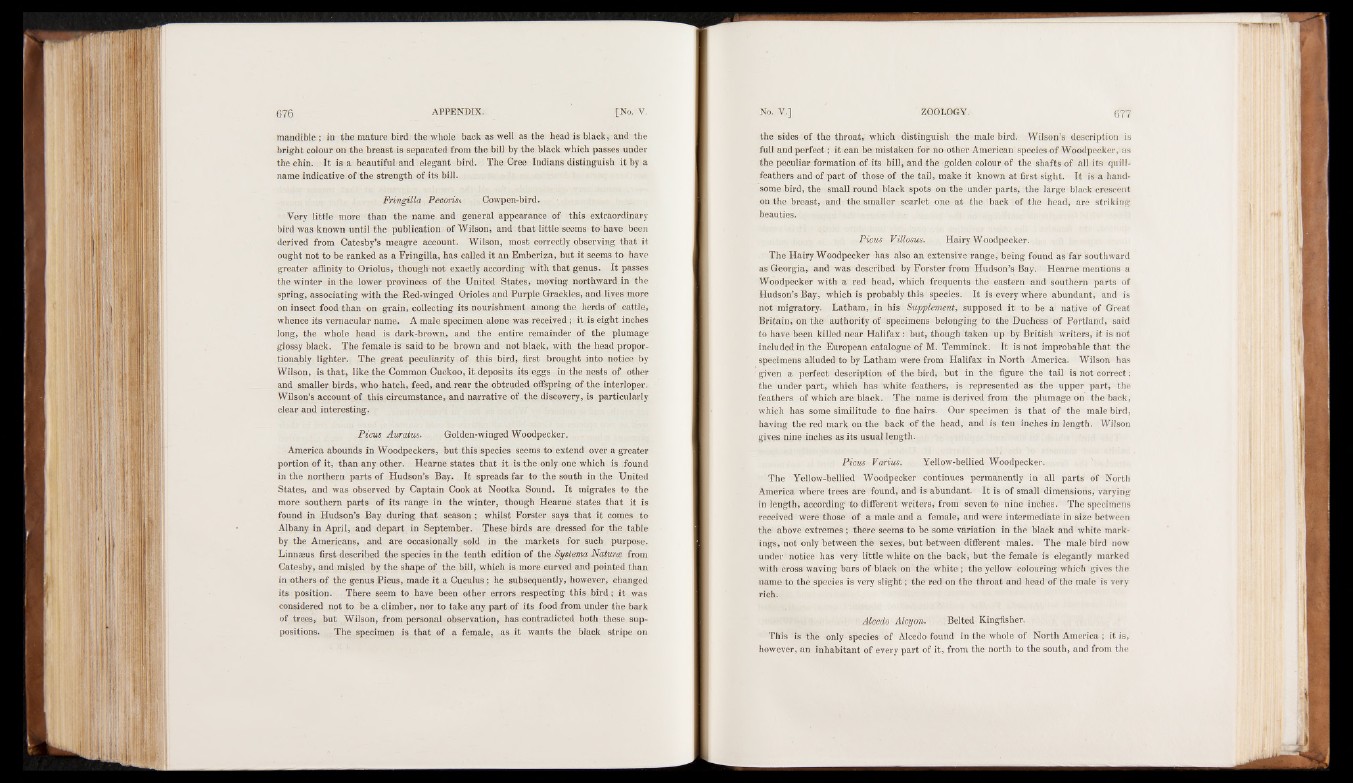
mandible ; in the mature bird the whole back as well as the head is black, and the
bright colour on the breast is separated from the bill by the black which passes under
the chin. It is a beautiful and elegant bird. The Cree Indians distinguish it by a
name indicative of the strength of its bill.
Fringilla. Pecorisf. Cowpen-bird.
Very little more than the name and general appearance of this extraordinary
bird was known until the publication of Wilson, and that little seems to have been
derived from Catesby’s meagre account. Wilson, most correctly observing that it
ought not to be ranked as a Fringilla, has called it an Emberiza, but it seems to have
greater affinity to Oriolus, though not exactly according with that genus. It passes
the winter in the lower provinces of the United States, moving northward in the
spring, associating with the Red-winged Orioles and Purple Grackles, and lives more
on insect food than on grain, collecting its nourishment among the herds of cattle,
whence its vernacular name. A male specimen alone was received ; it is eight inches
long, the whole head is dark-brown, and the entire remainder of the plumage
glossy black. The female is said to be brown and not black, with the head propor-
tionably lighter. The great peculiarity of this bird, first brought into notice by
Wilson, is that, like the Common Cuckoo, it deposits its eggs in the nests of other
and smaller birds, who hatch, feed, and rear the obtruded offspring of the interloper.
Wilson’s account of this circumstance, and narrative of the discovery, is particularly
clear and interesting.
Picus Auratus. Golden-winged Woodpecker.
America abounds in Woodpeckers, but this species seems to extend over a greater
portion of it, than any other. Hearne states that it is the only one which is found
in the northern parts of Hudson’s Bay. It spreads far to the south in the United
States, and was observed by Captain Cook at Nootka Sound. It migrates to the
more southern parts of its range in the winter, though Hearne states that it is
found in Hudson’s Bay during that season; whilst Forster says that it comes to
Albany in April, and depart in September. These birds are dressed for the table
by the Americans, and are occasionally sold in the markets for such purpose.
Linnasus first described the species in the tenth edition of the Systema Natures from
Catesby, and misled by the shape of the bill, which is more curved and pointed than
in others of the genus Picus, made it a Cuculus; he subsequently, however, changed
its position. There seem to have been other errors respecting this bird; it was
considered not to be a climber, nor to take any part of its food from under the bark
of trees, but Wilson, from personal observation, has contradicted both these suppositions.
The specimen is that of a female, as it wants the black stripe on
the sides of the throat, which distinguish the male bird. Wilson’s description is
full and perfect; it can be mistaken for no other American species of Woodpecker, as
the peculiar formation of its bill, and the golden colour of the shafts of all its quill-
feathers and of part of those of the tail, make it known at first sight. It is a handsome
bird, the small round black spots on the under parts, the large black crescent
on the breast, and the smaller scarlet one at the back of the head, are striking
beauties.
Picus Villosus. Hairy Woodpecker.
The Hairy Woodpecker has also an extensive range, being found as far southward
as Georgia, and was described by Forster from Hudson’s Bay. Hearne mentions a
Woodpecker with a red head, which frequents the eastern and southern parts of
Hudson’s Bay, which is probably this species. It is every where abundant, and is
not migratory. Latham, in his Supplement, supposed it to be a native of Great
Britain, on the authority of specimens belonging to the Duchess of Portland, said
to have been killed near Halifax: but, though taken up by British writers, it is not
included in the European catalogue of M. Temminck. It is not improbable that the
specimens alluded to by Latham were from Halifax in North America. Wilson has
given a perfect description of the bird, but in the figure the tail is not correct;
the under part, which has white feathers, is represented as the upper part, the
feathers of which are black. The name is derived from the plumage on the back,
which has some similitude to fine hairs. Our specimen is that of the male bird,
having the red mark on the back of the head, and is ten inches in length. Wilson
gives nine inches as its usual length.
Picus Varius. Yellow-bellied Woodpecker.
The Yellow-bellied Woodpecker continues permanently in all parts of North
America where trees are found, and is abundant. It is of small dimensions, varying
in length, according to different writers, from seven to nine inches. The specimens
received were those of a male and a female, and were intermediate in size between
the above extremes ; there seems to be some variation in the black and white markings,
not only between the sexes, but between different males. The male bird now
under notice has very little white on the back, but the female is elegantly marked
with cross waving bars of black on the white ; the yellow colouring which gives the
name to the species is very slight; the red on the throat and head of the male is very
rich.
Alcedo Alcyon. Belted Kingfisher.
This is the only species of Alcedo found in the whole of North America ; it is,
however, an inhabitant of every part of it, from the north to the south, and from the